
All images © by Roberto Piperno, owner of the domain. Write to romapip@quipo.it.
Notes:
Page added in September 2025.

All images © by Roberto Piperno, owner of the domain. Write to romapip@quipo.it.
Notes:
Page added in September 2025.
 Massa Marittima - The Town
Massa Marittima - The TownFor an introduction to Maremma and a map of the region you may wish to read this page first.

"Città Vecchia" (the oldest part of Massa Marittima) seen from the fortress of "Città Nuova"; in the background the Gulf of Follonica
A continual descent of many miles (from Volterra) through a wild tract of oak forests, underwooded with tamarisk, laurestinus, and brushwood, leads to the plain of Massa. That city crowns the extremity of a long range of heights, and at a distance is not unlike Harrow as seen from Hampstead Heath; but its walls and towers give it a more imposing air.
This height commands a magnificent view. The wide Maremma lies outspread at your feet, and the eye is led across it by a long straight road to the village of Follonica on the coast, some twelve or thirteen miles distant. Monte Calvi rises on the right, overhanging the deep vale of the Cornia; and many a village sparkles out from its wooded slopes. The heights of Piombino and Populonia rise beyond it, forming the northern horn of the Bay of Follonica; the headland of Troja (today's Punta Ala), with its subject islet, forms the southern; and the dark, abrupt peaks of Elba, the dim island of Monte Cristo, and the deep blue line of the Mediterranean, bound the horizon.
George Dennis - The Cities and Cemeteries of Etruria - 1848.
May 1790. During the latter part of my journey, I followed the track of the Via Aurelia which led from Rome to Pisa, and from thence to the south of France. I found none of the strata of stones entire. It still bears the name of Via Romana. The plain which I traversed is fertile and produces great crops of corn.
Richard Colt Hoare - A classical tour through Italy and Sicily - publ. in 1819

I proceeded, dined at Follonica, where the iron works belonging to the Prince of Piombino are situated. Hoare
The rock here is a rich red tufo, much indurated, and picturesquely overhung with ilex. Traces of volcanic action are occasionally met with in this part of Italy, though the higher mountains are of limestone, sandstone, or clay slate. Dennis
This part of Maremma (Colline Metallifere - Metal-bearing Hills) and the nearby Isle of Elba are rich of minerals (mainly copper, silver and iron) which were exploited since ancient times. Today production is very limited, but in the XIXth century it was a remarkable economic resource. The abundance of vegetation and therefore of wood is also linked to mining activity, which is essential both for reinforcing the mine tunnels and for fuelling the furnaces for melting metals.
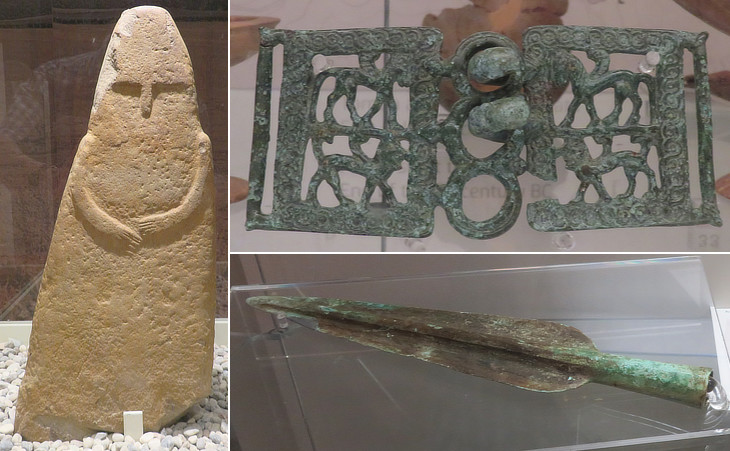
Museo Archeologico di Massa Marittima: (left) a funerary stone stela which was discovered in 1955 near the town (IIIrd millennium BC); (right) Etruscan bronze artifacts: (above) VIIth century BC buckle decorated with sphinxes and winged horses; (below) tip of a spear
Massa has been supposed by some to occupy the site of Vetulonia, an opinion founded principally on the epithet Veternensis, attached to a town of this name by Ammianus Marcellinus, the only (IVth century AD) writer who speaks of Massa, and which is regarded as a corruption of Vetuloniensis. The towns-people, ready to catch at anything that would confer dignity on their native place, have adopted this opinion, and it has become a local tradition; not to be the more credited on that account. I have little doubt, however, that there was originally an Etruscan population on the spot. Dennis
Massa does not stand upon the ruins of Vetulonia which have been identified near Castiglione della Pescaia, south of Follonica. Its territory however was inhabited even before the Etruscans developed their civilization.
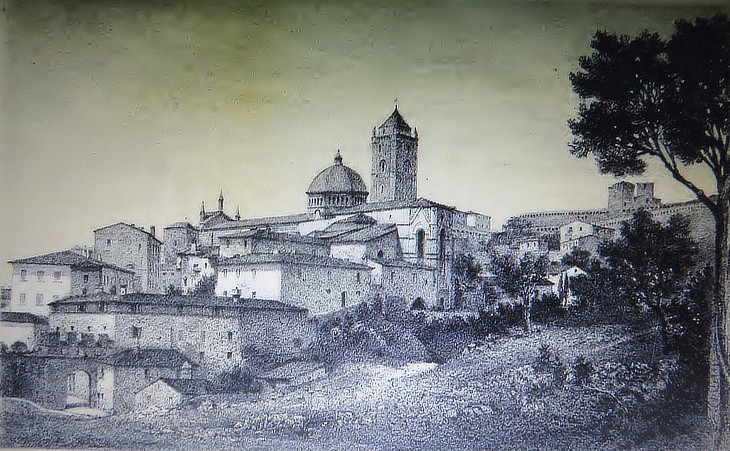
Though the see of a bishop, with nearly 3000 inhabitants, and one of the principal cities of the Maremma, Massa is a mean, dirty place, without an inn - unless the chandler's shop, assuming the name of "Locanda del Sole," may be so called.
Its elevated position might be supposed to secure Massa from the pestiferous atmosphere of the Maremma; but such is not the case. The city does not suffer so much as others on lower ground, yet has a bad name, proverbialized by the saying "Massa, Massa - Salute passa" (Health goes away). (..) It is a dreary road to Follonica across the barren plain. Follonica, indeed, is much more frequented, having a little port, and large iron factories; and lying on the high-road from Leghorn to Civita Vecchia. This little industrious village appears quite civilised after the dreary dullness of Massa. Dennis
(Travelling along the coastal railway which was opened in 1867) if the Maremma is as malarial as it is famed, it does not look it. There were stretches of hopeless morass, with wide acreages under water, but mostly, I should say, it was rather a hilly country. Now and then we ran by a stony old town on a distant summit like the outcropping of granite or marble, and there were frequent breadths of woodland, oak and pine and, I dare say, walnut and chestnut. Evidently there had been efforts to reclaim the Maremma from its evil air and make it safely habitable, and the farther we penetrated it the more frequent the evidences were.
William Dean Howells - Roman holidays, and others - 1908
By 1870 the northern section of Maremma was reclaimed and the railway favoured the development of Follonica which until 1923 was part of the Comune di Massa. Today it has more than 20,000 inhabitants, whereas Massa barely reaches 8,000. It is formally called Massa Marittima to distinguish it from other Italian towns by the same name, although today its territory does not reach the sea. It was also known as Massa di Maremma.
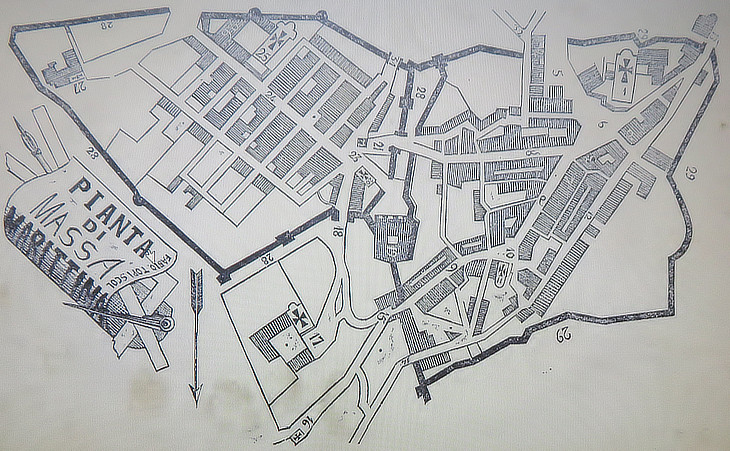
The town is clearly divided in two sections. The older one developed in the XIth century when the Bishops of Populonia, an ancient Etruscan/Roman port opposite Elba, set their residence at Massa, after Populonia had been raided and eventually destroyed by pirates. The new settlement was on high ground, but not at the very top of the hill which was fortified in the XIIIth century when Massa was a libero Comune (Repubblica di Massa) and its economy was thriving mainly thanks to the exploitation of silver mines. The relevance of being a bishopric see and the construction of the Cathedral are covered in a second page.

The Republic of Massa was founded in 1225 when the Bishop gave up his historical rights over the town. At the time Massa was under the protection of the Republic of Pisa, but in 1241 it made an alliance with that of Siena which lasted for almost a century, although from time to time there were conflicts for the control of some mines. In 1330 the conflict became an open war with the intervention of Pisa in support of Massa. The Republic of Florence tried to broker a peace, but in 1335 the troops of Siena, helped by some local families seized Massa and the town became a possession of Siena.

Palazzo dei Podestà: coats of arms of the Podestà and of the commissaries sent by Siena and Florence (see similar series of armorial bearings at Volterra, Arezzo and Cortona); (inset) a 1468 relief depicting the She-Wolf of Siena. The image used as background for this page shows a rampant lion, the symbol of Massa inside a coat of arms at the top of the palace
The podestà was a magistrate who exercised supreme power in a libero Comune (free Town), usually for a short period of time. In order to avoid the intense strife so common in Italian civic life, the podestà was a foreigner, but in the case of Massa he was very often from Siena. He was assisted by the Priori (the first citizens), leaders of the most important guilds or families, and by an assembly of 90 members. The palace was built in 1230 and it had merlons; some of its windows were walled because of later modifications, but they were restored in the XXth century.
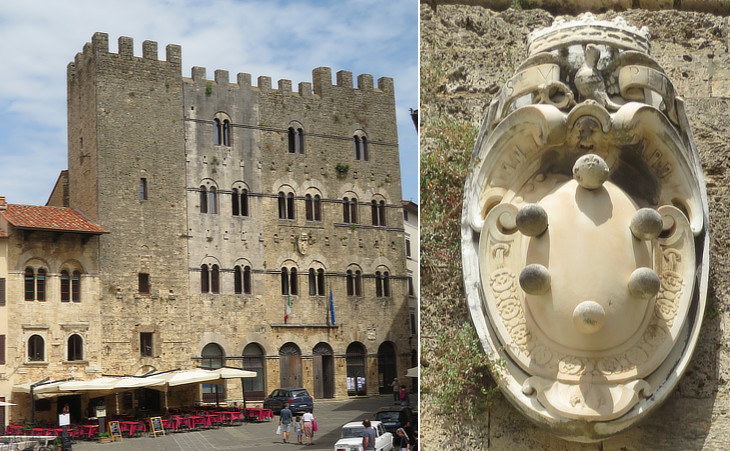
(left) Palazzo Comunale (Town Hall); (right) 1563 coat of arms of Cosimo I de' Medici Duke of Siena with the motto "Semper" (always) which alludes to the perpetuity of the Medici dynasty, surrounded by the collar of the Golden Fleece; the dove symbolizes the restoration of law and order by Cosimo after Massa had been occupied by Spanish troops in 1554
The palace was created by uniting two existing towers. That to the right was built in the XIIIth century as office (and prison) of the Bargello, the officer in charge of policing the town and in origin it was higher than it is today. That to the left was built in 1344 for the Conti di Biserno, a powerful local family who owned also the small palace adjoining the tower.
In 1559 at the end of a long war and in the frame of the Peace of Cateau-Cambrésis between France and Spain, the Republic of Siena was assigned as a separate dukedom to Cosimo de' Medici, Duke of Florence. The two dukedoms were united in 1569 when Pope Pius V granted Cosimo the title of Grand Duke of Tuscany (see an inscription at Montepulciano referring to him as Duke of both Florence and Siena).
An inscription indicates that the building was erected in 1265 by a podestà from Pisa. Three massive arcades sheltered the public fountain and supported a large hall where provisions were stored (this part was turned into a small theatre in 1833). The design of the fountain is similar to that of public fountains of Siena, e.g. Fonte Branda. The fountain was decorated with frescoes one of which is rather peculiar. In general it is thought to depict a large tree as symbol of abundance. The phalli which hang from the branches were most likely an apotropaic (against evil eye) symbol, which was inherited from an ancient Roman tradition.
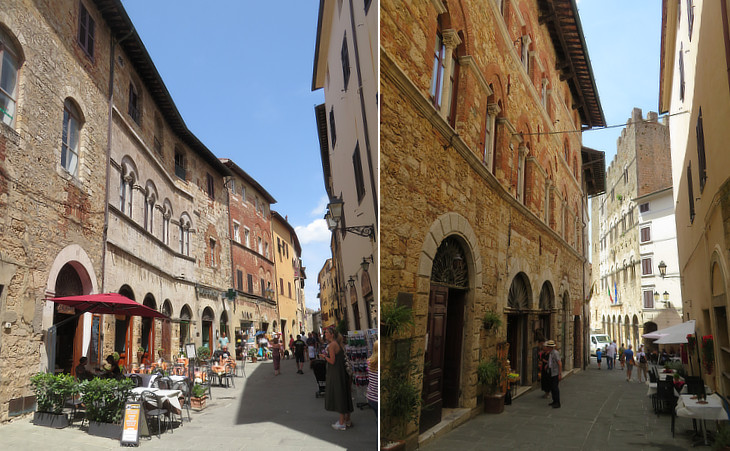
(left) Via della Libertà, the main street of Città Vecchia; (right) Via Annibale Moncini, an XVIIIth century local philanthropist, which leads to Città Nuova
Massa greatly declined during the XVIIth century and in 1737, when the last of the Medici died, it had only 527 inhabitants, of which 192 in the Old Town and 255 in the New Town. This explains why its main streets retain a very evocative medieval aspect.
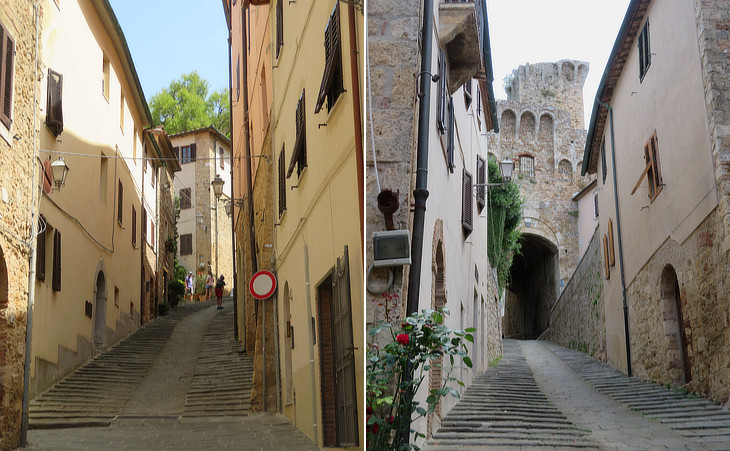
(left) En route to Città Nuova; (right) Porta a le Silici, giving access to Città Nuova
The new town was strongly fortified by the Republic of Siena after it had conquered Massa. The top of the hill was in a very commanding position and even a small garrison could hold it in case of a rebellion. In general the wealthiest citizens lived in the old town and workers or new settlers in the new one.
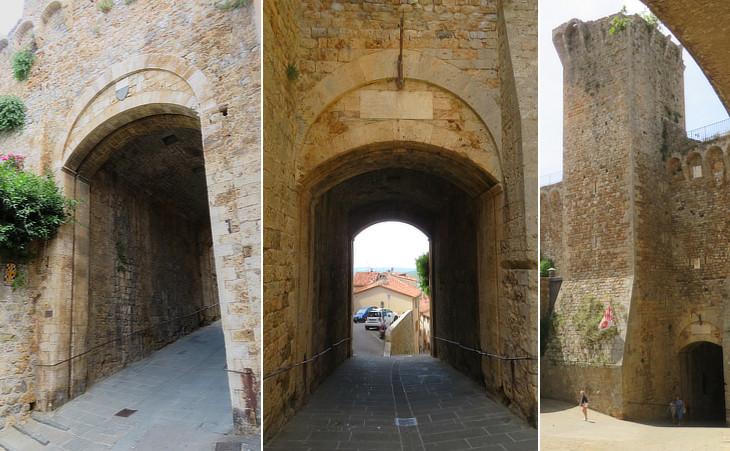
Views of Porta a le Silici (the name could refer to a stone (selci) quarry or to the stones of the tower itself (see Torre in Selci along Via Appia Antica); the left image shows also the white and black coat of arms of Siena
The gate is actually a double one with a distance of 15 meters between its two sides. It was possible to close its entrances by lowering an iron grid from above. An inscription states it was begun in 1337, but a second one celebrates its restoration or most likely its upgrading to the needs of cannon warfare in 1525, when the rivalry between Siena and Florence was fast reaching its dramatic epilogue.

(left) Torre del Candeliere; (right) a section of the walls of Città Nuova
Torre del Candeliere or dell'Orologio was erected by Massa before it was conquered by Siena. It was eventually linked by an arch to the wall of the Cassero (castle/keep) Senese, i.e. the new fortifications built by Siena (see other fortifications in Tuscany which are known as cassero at Grosseto and Castiglion Fiorentino). In 1554 in the context of the conflict between Spain and France, the Spaniards waged war to Siena and their troops managed to conquer Città Vecchia. At that point an embassy was sent by the citizens of the latter to the commander of the Cassero asking him to surrender and spare the town further destruction. This occurred after a few days in the hands of an envoy of Cosimo de' Medici.

(left) Porta S. Rocco or Porta Senese, another double gate of the fortifications of Città Nuova; (right) the main street of Città Nuova
The most important families of Massa lived in Città Vecchia, which explains why Città Nuova does not have major monuments, exception made for a former large monastery of the Augustinians.
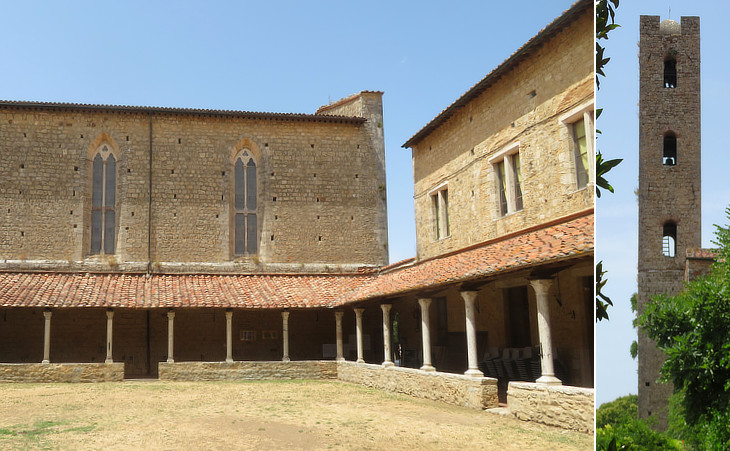
S. Agostino: (left) cloister; (right) bell tower, initially built as a watching tower of the fortifications
Move to the Cathedral.
In Maremma - other pages:
Corneto (Tarquinia)
Corneto (Tarquinia) - Palazzo Vitelleschi and Museo Archeologico Nazionale di Tarquinia
Tarquinia - Etruscan Necropolis of Monterozzi
Montalto di Castro and Canino
An Excursion to Orbetello
An Excursion to Porto Ercole
An Excursion to Grosseto
An Excursion to Volterra

